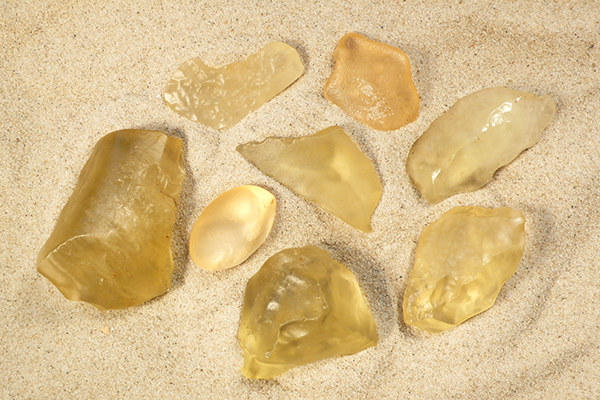Ancient "desert glass" turns out to be from a 29-million-year-old meteorite

(Natural News) A common desert glass scattered in the Libyan desert came from a meteor event that happened over 29 million years ago, according to a recent study. Researchers from Curtin University in Australia and the National History Museum of Vienna discovered reidite – a mineral formed only during meteorite impact – in pieces of desert glass in the Libyan desert. Their study, which was published in the journal Geology, answered some long-standing debates on where Libyan desert glass (LDG) came from.
There was a meteor involved, but how?
The origins of LDG have always been a mystery. Found in the deserts of Libya and Western Egypt, the glass has been widely used as jewelry. In fact, it’s the material ancient jewelers used to create Tutankhamun’s pectoral scarab.
Scholars have long-standing debates on where LDG comes from. According to some, the glass is the result of a meteor outburst — similar to that of the recent Chelyabinsk meteor. Others, however, proposed that LDG was made from a meteor impact.
A meteor outburst refers to a phenomenon where the air that flowed inside the meteor percolated within and caused it to explode. While several asteroids called Near-Earth Objects (NEO) pass and enter the Earth’s atmosphere, but they usually burn away as they fall to the surface. In February 2013, however, a meteor exploded above the skies of Russia in an outburst, injuring almost 1,500 people and causing millions of dollars worth of damages.
While earlier studies have suggested that LDG could have been the result of a meteor outburst, recent evidence to support the phenomenon is thin. This led others to assert that the glass was from a meteor impact. Both theories were possible, so it was difficult to ascertain which was true due to the lack of evidence.
Sponsored solution from CWC Labs: This heavy metals test kit allows you to test almost anything for 20+ heavy metals and nutritive minerals, including lead, mercury, arsenic, cadmium, aluminum and more. You can test your own hair, vitamins, well water, garden soil, superfoods, pet hair, beverages and other samples (no blood or urine). ISO accredited laboratory using ICP-MS (mass spec) analysis with parts per billion sensitivity. Learn more here.
In this study, the researchers decided to a closer look into LDG to determine which theory was closer to the truth.
Discovering the rarest mineral on Earth
For the current study, the team sampled zircon grains found in LDG samples. Zircon is a minor component of all kinds of rocks. Its crystals are often used as gemstones due to their wide range of colors.
Zircon is usually unnoticeable on rocks and sediments because of its minuscule particle size, often no bigger than a millimeter. But the team found that the sample zircon grains preserved reidite. The rare mineral forms when zircon is placed under exceedingly high amounts of pressure, like a meteor impact.
This led researchers to conclude that LDG was formed during an event that produced high-pressure shock waves – something that isn’t possible during a meteor airburst.
“Both meteorite impacts and airbursts can cause melting, however, only meteorite impacts create shock waves that form high-pressure minerals, so finding evidence of former reidite confirms it was created as the result of a meteorite impact,” added Cavosie.
Researchers also warned that people should be careful of using LDG and other glasses that come from high-pressure rock deformation as evidence of airbursts. (Related: NASA updates its plan to deflect potentially hazardous Earth-bound asteroids.)
Learn about other scientific discoveries related to history, space – and everything in between – at Research.news.
Sources include:



